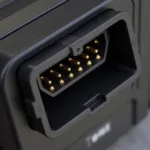OBD2 vehicles represent a significant advancement in automotive technology, introducing standardized diagnostics that have revolutionized vehicle maintenance and repair. But what exactly defines an OBD2 vehicle? This comprehensive guide delves into the world of OBD2 vehicles, explaining their history, functionality, and the benefits they offer to vehicle owners and mechanics alike.
Understanding OBD2 and its Significance
OBD stands for On-Board Diagnostics, and as the name suggests, it refers to a vehicle’s built-in diagnostic system. This system monitors various components and systems within the vehicle, detecting malfunctions and alerting the driver through dashboard warning lights, such as the “Check Engine” light.
OBD2, the second generation of this technology, was introduced in 1996 and brought about a universal standard for vehicle diagnostics. Prior to OBD2, each manufacturer had its own proprietary diagnostic system and connectors, making it challenging for mechanics to diagnose and repair vehicles from different brands.
The standardization of OBD2 brought forth numerous benefits:
- Universal Compatibility: All OBD2-compliant vehicles, regardless of make or model, utilize the same 16-pin diagnostic connector and communication protocol. This allows mechanics to use a single OBD2 scanner to diagnose a wide range of vehicles.
- Enhanced Diagnostics: OBD2 provides access to a broader range of data points compared to its predecessor, including engine performance, emissions, transmission, and other critical systems.
- Simplified Repair: By providing detailed diagnostic trouble codes (DTCs), OBD2 helps pinpoint the root cause of malfunctions, facilitating faster and more accurate repairs.
- Empowered Vehicle Owners: Affordable OBD2 scanners enable car owners to access their vehicles’ diagnostic data, interpret fault codes, and gain insights into their car’s health.
Identifying OBD2 Vehicles
While OBD2 became mandatory for all gasoline-powered vehicles sold in the United States in 1996, the implementation timeline varies for other regions and vehicle types.
- Model Year: Generally, gasoline-powered vehicles manufactured from 1996 onwards are OBD2 compliant. However, it’s always best to verify compatibility using resources like your vehicle owner’s manual or online databases.
- Diesel Vehicles: OBD2 compliance for diesel vehicles typically began in model year 2008.
- OBD2 Port: Look for the standardized 16-pin OBD2 diagnostic connector. It’s usually located under the dashboard on the driver’s side, though the exact location may vary.
The Power of OBD2 Scanners
OBD2 scanners serve as the interface between your vehicle’s computer and the outside world. These devices, ranging from basic code readers to advanced professional-grade tools, allow you to:
- Retrieve and Clear Diagnostic Trouble Codes (DTCs): OBD2 scanners read the DTCs stored in your vehicle’s computer, providing insights into specific malfunctions. They can also clear these codes once the underlying issue has been addressed.
- View Live Data Stream: Monitor real-time sensor data such as engine RPM, coolant temperature, oxygen sensor readings, and more, allowing for dynamic vehicle analysis.
- Perform Advanced Functions: Depending on the scanner’s capabilities and your vehicle’s make and model, you might be able to perform tasks like ABS bleeding, airbag system resets, and transmission adaptations.
Choosing the right OBD2 scanner depends on your needs and budget. For basic code reading and clearing, affordable options are readily available. However, professional mechanics and enthusiasts seeking advanced functionality require more sophisticated scanners with extensive features.
OBD2 and the Future of Automotive Technology
OBD2 has significantly impacted the automotive industry, and its influence continues to grow. With advancements in technology and the rise of connected cars, OBD2 is evolving to offer even greater capabilities, including:
- Remote Diagnostics: Imagine receiving real-time vehicle diagnostics and alerts on your smartphone, allowing for proactive maintenance and early problem detection.
- Predictive Maintenance: By analyzing historical data and usage patterns, OBD2 systems can predict potential component failures, minimizing unexpected breakdowns and optimizing maintenance schedules.
- Integration with Third-Party Apps: The wealth of data accessible through OBD2 opens doors for innovative third-party applications that can enhance vehicle performance, improve fuel efficiency, and provide personalized driving insights.
Conclusion
OBD2 has revolutionized vehicle diagnostics, transforming how we maintain and repair our cars. Understanding what constitutes an OBD2 vehicle empowers you to take control of your vehicle’s health, enabling informed maintenance decisions and potentially saving you time and money in the long run. As technology advances, OBD2 will continue to play a pivotal role in shaping the future of automotive technology, making our vehicles safer, more reliable, and even more connected.
FAQs about OBD2 Vehicles
1. Are all cars manufactured after 1996 OBD2 compliant?
While the 1996 mandate applies to gasoline-powered vehicles sold in the United States, compliance for other regions and vehicle types may vary. It’s essential to confirm compatibility based on your vehicle’s make, model, and year.
2. Can I use any OBD2 scanner on my vehicle?
While all OBD2-compliant vehicles use the same connector, certain scanners offer vehicle-specific functionalities. Ensure your chosen scanner supports your vehicle’s make and model.
3. What should I do after reading a DTC with an OBD2 scanner?
Research the specific DTC online or consult a qualified mechanic. Remember, clearing the code without addressing the underlying issue is a temporary fix.
4. Can I install an OBD2 port in an older vehicle?
It’s technically possible, but the complexity varies depending on the vehicle’s existing wiring and computer systems. Consult a professional for guidance.
5. Do electric vehicles (EVs) use OBD2?
EVs have their own diagnostic systems, often with OBD2-like connectors and functionalities. However, the specific protocols and data points may differ.
best obd2 skanner for japanese and european vehicles
Need further assistance? Don’t hesitate to reach out to our dedicated team via WhatsApp at +1(641)206-8880 or email us at [email protected]. We’re available 24/7 to answer your OBD2 queries.

